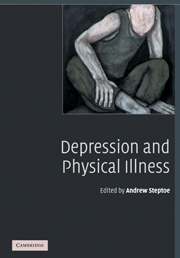Book contents
- Frontmatter
- Contents
- List of contributors
- Preface
- Part 1 Introduction to depression and its determinants
- 1 Depression in the medically ill
- 2 Psychosocial factors, depression and illness
- Part 2 Depression and specific health problems
- Part 3 Biological and behavioural processes
- Part 4 Conclusions
- Index
- References
2 - Psychosocial factors, depression and illness
from Part 1 - Introduction to depression and its determinants
Published online by Cambridge University Press: 17 September 2009
- Frontmatter
- Contents
- List of contributors
- Preface
- Part 1 Introduction to depression and its determinants
- 1 Depression in the medically ill
- 2 Psychosocial factors, depression and illness
- Part 2 Depression and specific health problems
- Part 3 Biological and behavioural processes
- Part 4 Conclusions
- Index
- References
Summary
Introduction
Depression, including the full range of minor to major depressive disorders, is a common and disabling condition. As with most psychological disorders, the aetiology of depression is multifactorial, but social and psychological factors play a more prominent role in its aetiology than in most other conditions in medicine. This has importance both in understanding the aetiology and in finding opportunities for prevention and devising psychological and social treatments.
This chapter describes the evidence for social and psychological factors playing a role in the aetiology of depression. Social factors include general factors at the level of human society concerned with social structure and social processes that impinge on the individual. Psychological factors include individual-level processes and meanings that influence mental states. Sometimes these words are combined as ‘psychosocial’. This is a shorthand term for the combination of psychological and social, but it also implies that the effect of social processes is sometimes mediated through psychological understanding. Hence, it has been said that the impact of social inequality on health may be mediated partly through perceptions of shame.
Much of the data on psychosocial factors and mental health deal with broader categories than depression, such as common mental disorder, of which depression is a prominent component. This chapter focuses on depressive disorders but also includes landmark studies that have used the broader categories that illustrate the role of psychosocial variables.
Sociodemographic factors
Gender differences in depression
Both major and minor depressive disorders are more common in women than men [1, 2].
Keywords
- Type
- Chapter
- Information
- Depression and Physical Illness , pp. 19 - 50Publisher: Cambridge University PressPrint publication year: 2006
References
- 8
- Cited by

